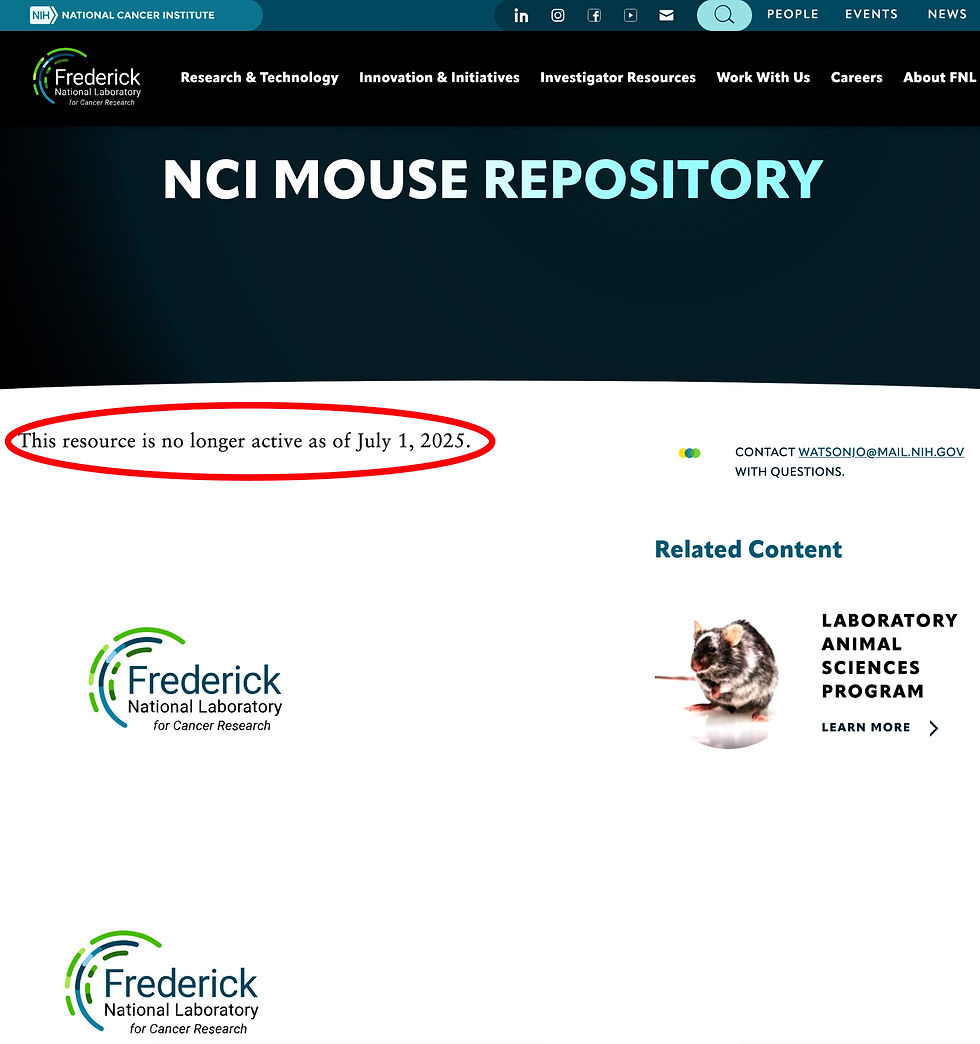The Day the Mice Went Dark: The NCI Mouse Repository shuts down (#395)
- Rick LeCouteur
- Aug 18
- 4 min read

The NCI Mouse Repository is gone.
Here's what we lose and what should happen next.
On July 1, 2025, the National Cancer Institute (NCI) confirmed that the NCI Mouse Repository (NMR) is no longer active.
This ends a federal program that, for years, distributed rigorously curated mouse cancer models and related embryonic stem cell lines to labs around the world.

What the repository did
Housed at Frederick National Laboratory and supported by NCI’s Division of Cancer Biology, the NMR centralized the cryopreservation, quality control, and distribution of genetically engineered mouse models (GEMMs) and associated materials, often as frozen germplasm, so any qualified lab (academic, non-profit, or commercial) could reproduce pivotal experiments.
This work sat within a larger, bench-to-bedside pipeline of integrated husbandry, rederivation, diagnostics, pathology, imaging, and regulatory support, that helped investigators move findings from cells to animals to human trials with healthy, well-characterized animals.
Historically, the repository also aligned with NCI’s longstanding push to standardize and share mouse cancer models (e.g., the Mouse Models of Human Cancers Consortium), which underpinned thousands of studies in tumor biology, genetics, and therapy response.
Concrete contributions to science & cancer research
Reproducibility and access. By distributing archived strains and embryonic stem cells with documented provenance, NMR made key models available beyond the labs that created them. This was critical for validation, meta-analysis, and cross-site preclinical testing.
Speed and cost efficiency. Centralized cryopreservation and rederivation spared labs the expense and risk of maintaining rare lines, while enabling quick recovery of models after contamination or facility downtime.
Translation. Standardized animal care, molecular monitoring, and histopathology increased the reliability of preclinical efficacy and toxicity signals, sharpening go/no-go decisions for therapies headed toward the clinic.
What the shutdown means for researchers and for patients
Immediate risk to reproducibility. Models that anchored influential studies may become harder or impossible to obtain, fragmenting the field as labs substitute near-equivalents with subtly different genetics or microbiomes. That splinters data comparability and slows consensus on therapeutic targets.
Loss of rare or at-risk strains. Without proactive transfer, some low-demand but high-impact models (e.g., tumor suppressor combinations, lineage-specific reporter lines) risk extinction through attrition or drift in private colonies.\
Higher costs and delays. Labs must spend to recreate lines, secure licensing, or arrange bespoke cryo-recovery, which diverts dollars and months from experiments that could be informing trials.
Equity hit. Under-resourced institutions and global-south collaborators disproportionately relied on federally supported access; the barrier to entry rises without a centralized, low-cost supplier.
Workforce and know-how leakage. Specialized husbandry, rederivation, and quality control expertise can dissipate if staff are not retained within a successor program. This is knowledge that isn’t easily rebuilt.
These are reasoned implications drawn from how repositories function in NCI’s research ecosystem and from the stated scope of NMR and Laboratory Animal Sciences Program services.
What (partially) fills the gap
MMRRC (Mutant Mouse Resource & Research Centers). A national NIH-supported network that archives and distributes scientifically valuable mice and ES cell lines. If NMR strains migrate here, continuity can be preserved.
IMSR (International Mouse Strain Resource). A global index that helps you locate strains across repositories; watch here for any re-homed NMR lines.
Commercial and academic cores (e.g., JAX, campus mouse biology cores). These offer overlapping services but may differ in cost, licensing, or model availability.
What funders and operators should do now
Transfer the archive with integrity. Move cryo-stocks, metadata, and SOPs to established repositories (e.g., MMRRC/JAX), maintaining model identifiers (RRIDs) and versioned genotyping protocols so records remain traceable.
Publish a definitive catalog & redirect map. Freeze a public list of all NMR strains and where each is going, with persistent IDs and DOIs for methods and QC documents.
Bridge funding and staff retention. Keep the cryo/QC experts employed through the transition; people are the “cold chain” for scientific quality.
Central help desk. Maintain a single contact for legacy requests and tech transfer questions during the handoff (NCI’s contact page notes the closure and provides a point of contact).
Sustainability plan. Embed long-term, line-item support for repository infrastructure into NCI’s portfolio so the research community isn’t whipsawed by future contract cycles.
Rick’s Commentary
The NCI Mouse Repository’s closure is a real setback for rigor, equity, and pace in preclinical cancer research.
The cost isn’t abstract: it’s slower validation, noisier data, and delayed therapies for patients who can’t afford the wait.
Here’s just one example of what this closure means for those suffering from pancreatic cancer:
Pancreatic cancer moves fast and leaves little margin for error.
The shutdown of the NCI Mouse Repository means slower, noisier progress on the treatments they’re hoping will arrive in time.
Pancreatic tumors are notoriously complex; researchers rely on carefully characterized mouse models to test drug combinations, radiation sensitizers, immunotherapy strategies, and early-detection biomarkers before anything reaches a clinical trial.
Without a centralized, low-cost source of those models, labs will spend more money and months recreating or substituting strains, results will be harder to compare across studies, and rare but vital models may disappear altogether.
That bottleneck doesn’t just affect scientists; it translates into fewer high confidence leads entering trials, longer waits for answers about what works, and a higher risk that promising ideas stall for lack of reproducible evidence.
In plain terms:
The pipeline from bench to bedside just got narrower at the very moment patients and families need it widest.
The amount of damage RFK is doing to humanity is enormous.
No one is going to pick up this research, at least not in the US.
If you get pancreatic cancer in 20 years and there are still no good treatments, remember this month when chaos reigned.



Comments